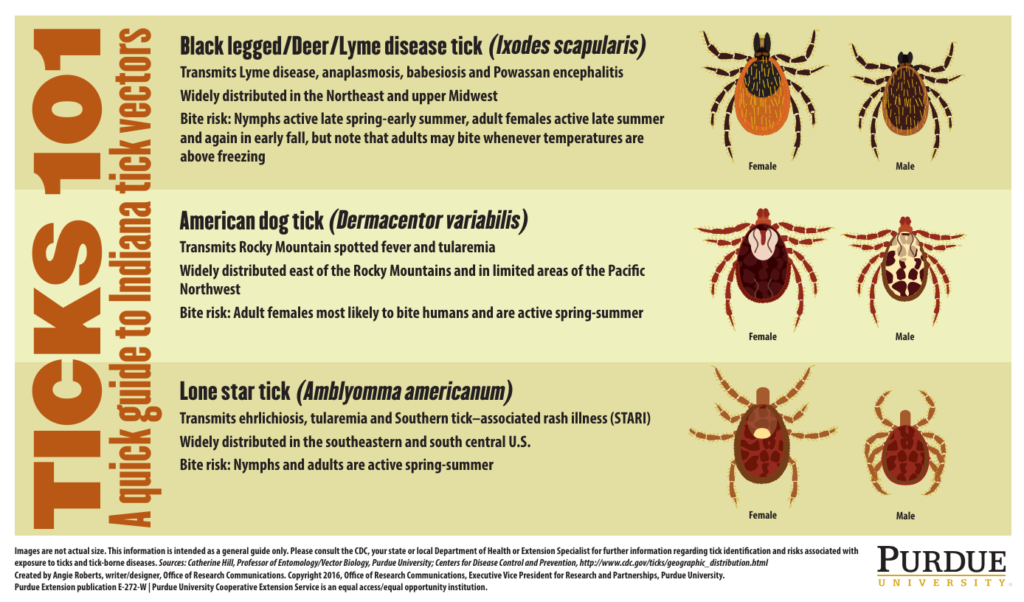What are Ticks?
Ticks are a member of the Arachnid family of insects. Like spiders, they have eight legs and can be found virtually everywhere in the United States. The size of ticks varies as they swell as they eat. Their primary and only source of nutrition is the blood of animals ranging from birds to dogs to humans, just like Mosquitoes. Of the nine species of ticks, the most common you’ll find in Maryland are the black-legged, American dog, and lone star ticks.

Myths vs Facts about Ticks
Myth: Once bitten, you are AUTOMATICALLY INFECTED with a tick-borne illness
Fact: In order to contract a tick-borne illness the tick would have to be attached to the skin for over 2 hours. The only known species of tick to carry Lyme Disease is the black-legged tick, with only 2% of bites causing Lyme Disease. The American dog tick and lone star tick carry Rocky Mountain spotted fever and STARI (Southern tick-associated rash illness), respectively.
Myth: Ticks burrow under the skin
Fact: Ticks do not borrow under the skin at all. In fact, once they have become full in 3-6 days, they will simply fall off.The main reason for this myth being believed by many is the fact that the area around where the tick is latched on swells and becomes inflamed, giving the illusion of it being burrowed into the skin.
Myth: You should remove ticks using heat or chemicals
Fact: Using heat and chemicals can make the removal process of a tick much harder and more painful. In fact, using heat to remove a tick can push the saliva further into the bite, increasing the risk for the bite to get infected.
How to properly Remove Ticks
What should you do once you get bit by a tick and discover it? Use a pair of clean, fine-tipped tweezers and gloves. Follow these steps to ensure the safe removal of a tick.
- Using the tweezers, grab the tick as close to the skin as possible, ensuring not to twist or jerk the tick
- Gently pull upwards until all parts of the tick are removed
- Clean the bite area with soap and water or rubbing alcohol
DO NOT USE THE FOLLOWING TO REMOVE A TICK
- Petroleum Jelly (Vaseline)
- A hot match
- Nail Polish
- Other chemical or heat-based products
Dangers of being bitten by a Tick
Think of the dangers of being bitten by a tick as the same as being bitten by a spider or mosquito. The largest risk from being bitten by a tick is Lyme Disease, but there are other tick-borne diseases to be aware of, including:
- Alpha-gal Allergy
- Babesiosis
- Ehrlichiosis and Anaplasmosis
- Powassan Virus
- Rocky Mountain Spotted Fever
- Southern Tick-Associated Rash Illness (STARI)
- Tularemia
Symptoms of Tick-Borne Diseases
For all tick-borne diseases, there is a list of similar symptoms to be aware of that includes
- Fever
- Headache
- Fatigue
- Rash
- Body Aches
If you or a loved one are experiencing such symptoms following a tick bite or being in an area where ticks are common, please contact your healthcare provider
How to Prevent a Tick Bite
Reducing exposure to ticks is the best defense against tick-borne diseases. You and your family can take several steps to prevent tick bites, including:
- Avoid highly wooded and grassy areas
- Stay to the center of the trail and wear long pants and sleeves if possible
- Wear lighter color clothing
- Wear EPA-approved repellent
- Total Home Woodland Scent Insect Repellent
- OFF!
- Ben’s 30 Tick & Insect Repellent
- Check for ticks once inside (pets, clothes, kids)
- Shower as soon as possible